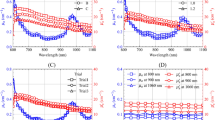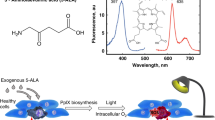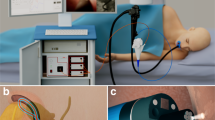Abstract
Necrosis of small volumes of tumour tissue with photodynamic therapy (PDT) can be achieved relatively easily. For this to be clinically relevant, it is essential to know what the same treatment parameters do to adjacent normal tissues into which the tumour has spread. For pancreatic cancers, local spread to vital structures is common. We have studied chemical extraction, microscopic fluorescence kinetics and photodynamic effects of disulphonated aluminum phthalocyanine (AlS2Pc) in normal pancreas and adjacent tissues in hamsters. Chemical extraction exhibited a peak duodenal concentration of AlS2Pc 48 h after sensitisation, with levels much higher than in stomach and pancreas. With microscopic fluorescence photometry highest levels were seen in duodenal submucosa and bile duct walls 48 h after photosensitisation. Pancreatic ducts, duodenal mucosa and gastric mucosa and submucosa exhibited intermediate fluorescence with relatively weak fluorescence in pancreatic acinar tissue and the muscle layer of the stomach. As expected, on the basis of fluorescence intensity and chemical extraction studies, the duodenal and bile duct wall were the most vulnerable tissues to photodynamic therapy. When the dose of 5 mumol kg-1 of sensitiser was used, duodenal perforations, gastric ulcers and transudation of bile from the bile duct occurred. However, the lesions in the stomach and bile duct healed without perforation or obstruction, so only the duodenum was at risk of serious, irreversible damage. Using a lower dose of photosensitiser markedly reduced damage.
This is a preview of subscription content, access via your institution
Access options
Subscribe to this journal
Receive 24 print issues and online access
$259.00 per year
only $10.79 per issue
Buy this article
- Purchase on Springer Link
- Instant access to full article PDF
Prices may be subject to local taxes which are calculated during checkout
Similar content being viewed by others
Author information
Authors and Affiliations
Rights and permissions
About this article
Cite this article
Nuutinen, P., Chatlani, P., Bedwell, J. et al. Distribution and photodynamic effect of disulphonated aluminium phthalocyanine in the pancreas and adjacent tissues in the Syrian golden hamster. Br J Cancer 64, 1108–1115 (1991). https://doi.org/10.1038/bjc.1991.473
Issue Date:
DOI: https://doi.org/10.1038/bjc.1991.473
This article is cited by
-
Traitement photodynamique du cancer du pancréas
Acta Endoscopica (2003)
-
Sensitization and photodynamic therapy of normal pancreas, duodenum and bile ducts in the hamster using 5-aminolaevulinic acid
Lasers in Medical Science (1996)



